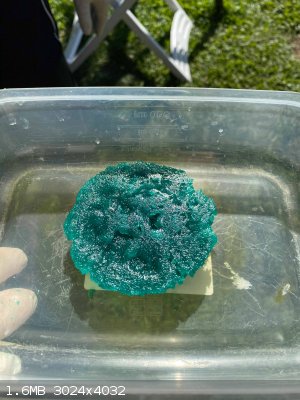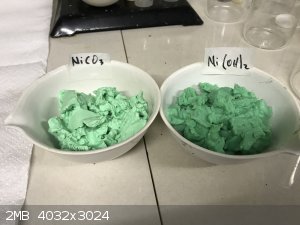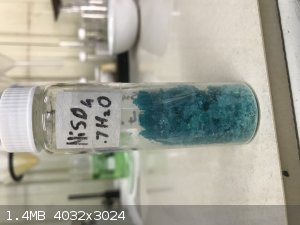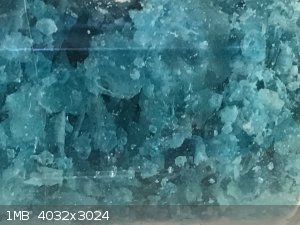Syn the Sizer
National Hazard
   
Posts: 591
Registered: 12-11-2019
Location: Canada
Member Is Offline
|
|
Nickel carbonate from Canadian nickels
Hello,
I was given a bag a change today and started sorting through it. I had notice a nickel from 1962 and 1950, knowing Canadian change had changed in 2001
I decided to look up the composition of nickels this old. Upon research I discovered Canadian nickels from 1946-1981 were chrome-steel plated and
99.9% nickel. I started checking the dates on the nickles and I have 15 within those dates @ ~4.54g/nickel is ~68.1g @ 99.9 68.03g theoretical of
nickel.
I had checked the post "Separation of a US nickel" and in Symbooms post he mentioned using tin to displace the copper. Am I going to need a similar process to deal with
the chrome-steel? I realize the iron would precip out as iron hydroxide but what about the chrome? Also should I cut the nickels up or will they
dissolve fine whole?
I plan on looking for some silver quarters too.
[Edited on 10-5-2020 by Syn the Sizer]
|
|
|
woelen
Super Administrator
        
Posts: 7976
Registered: 20-8-2005
Location: Netherlands
Member Is Offline
Mood: interested
|
|
Very simple. Put the coins in some nitric acid and allow the outer layer to dissolve.
Discard the solution.
Then take the coins out of the acid, rinse them well and dissolve them in new clean acid.
First try with one coin and a little amount of acid to see how quickly the thin outer layer dissolves.
|
|
|
Syn the Sizer
National Hazard
   
Posts: 591
Registered: 12-11-2019
Location: Canada
Member Is Offline
|
|
I unfortunately don't have nitric acid at the moment and was hoping to be able to use the HCl and H2O2 method. Today is a nice
day, maybe I will synthesizer some nitric acid, I only have calcium nitrate but also have sodium bisulfAte.
|
|
|
woelen
Super Administrator
        
Posts: 7976
Registered: 20-8-2005
Location: Netherlands
Member Is Offline
Mood: interested
|
|
H2O2 + HCl most likely also will dissolve the outer layer. Just try it. Once the outer layer has dissolved you get the pure nickel coin and that most
likely also will dissolve in HCl + H2O2. Maybe you need some patience, but let it brew overnight. Use high concentrations (e.g. 2 parts of 30% HCl + 1
part of 12% H2O2).
|
|
|
Syn the Sizer
National Hazard
   
Posts: 591
Registered: 12-11-2019
Location: Canada
Member Is Offline
|
|
Awesome, so I should let the coin(s) soak in HCl H2O2 for a bit to remove the outer layer than discard the solution rinse the coin and re-add to fresh
HCl/H2O2 solution.
I only have 29% H2O2, should I dilute to 12% to increase water content or is it better to just dial back the volume added and keep the 29%
concentration, I am guessing keep the concentration and lower the volume is the better option.
|
|
|
S.C. Wack
bibliomaster
    
Posts: 2419
Registered: 7-5-2004
Location: Cornworld, Central USA
Member Is Offline
Mood: Enhanced
|
|
51-54 were steel. Not others until 99.
|
|
|
Syn the Sizer
National Hazard
   
Posts: 591
Registered: 12-11-2019
Location: Canada
Member Is Offline
|
|
You are correct my source was wrong, I checked again and mint.ca does state that 51-54 were steel, but back to nickle from 55-81, good thing my oldest
nickel was 1950 and the next oldest is 1962 then 13 more between 62-81.
|
|
|
woelen
Super Administrator
        
Posts: 7976
Registered: 20-8-2005
Location: Netherlands
Member Is Offline
Mood: interested
|
|
Quote: Originally posted by Syn the Sizer  | Awesome, so I should let the coin(s) soak in HCl H2O2 for a bit to remove the outer layer than discard the solution rinse the coin and re-add to fresh
HCl/H2O2 solution.
I only have 29% H2O2, should I dilute to 12% to increase water content or is it better to just dial back the volume added and keep the 29%
concentration, I am guessing keep the concentration and lower the volume is the better option. |
I would not dilute anything. I mentioned 12%, because that is the highest concentration we can get over here. If you have 29% H2O2, then I would mix 3
parts of conc. HCl with 1 part of 29% H2O2 and add the coin. First try with a single coin and a small amount of acid and H2O2.
|
|
|
Syn the Sizer
National Hazard
   
Posts: 591
Registered: 12-11-2019
Location: Canada
Member Is Offline
|
|
@Woelen awesome, thank you very much for the input. I plan on starting that today.
|
|
|
Syn the Sizer
National Hazard
   
Posts: 591
Registered: 12-11-2019
Location: Canada
Member Is Offline
|
|
I didn't get around to it on the day planned, however I did start yesterday, but I was an idiot. I forgot I had started it and went to bed. I woke and
1/4 of the nickel was gone so I know it will dissolve the layers.
I was also thinking nickel (II) hydroxide would probably be better than nickel (II) carbonate for synthesis of other salts since it wouldn't produce
CO2.
[Edited on 16-5-2020 by Syn the Sizer]
[Edited on 16-5-2020 by Syn the Sizer]
|
|
|
pantone159
National Hazard
   
Posts: 586
Registered: 27-6-2006
Location: Austin, TX, USA
Member Is Offline
Mood: desperate for shade
|
|
I believe that most of these Canadian nickels are nearly pure Ni, without any steel plating. They were plated over steel back in the 1950s and
probably also now, but when the composition was Ni they were not plated with anything.
|
|
|
Syn the Sizer
National Hazard
   
Posts: 591
Registered: 12-11-2019
Location: Canada
Member Is Offline
|
|
Quote: Originally posted by pantone159  | I believe that most of these Canadian nickels are nearly pure Ni, without any steel plating. They were plated over steel back in the 1950s and
probably also now, but when the composition was Ni they were not plated with anything.
|
You are correct 51-54 were plated, but 55-81 were pure nickel. I saw 99.9% nickel and assumed they were plated but looked again and it only say plated
from 51-54.
|
|
|
AJKOER
Radically Dubious
    
Posts: 3026
Registered: 7-5-2011
Member Is Offline
Mood: No Mood
|
|
A galvanic cell approach should also likely work!
Add the coin to aqueous pure chlorine bleach (a mix of NaOCl/NaCl). In this cell, the Steel is the anode and you will need a large surface area noble
cathode. Choices could include silver, gold,..., or less stable graphite or activated carbon.
Jumpstart in a microwave.
Here is a reference on the attack of steel by hypochlorite at https://www.orf.od.nih.gov/TechnicalResources/Documents/DTR%... which likely occurs over time with a poor cathode.
[Edited on 16-5-2020 by AJKOER]
|
|
|
Syn the Sizer
National Hazard
   
Posts: 591
Registered: 12-11-2019
Location: Canada
Member Is Offline
|
|
Quote: Originally posted by AJKOER  | A galvanic cell approach should also likely work!
Add the coin to aqueous pure chlorine bleach (a mix of NaOCl/NaCl). In this cell, the Steel is the anode and you will need a large surface area noble
cathode. Choices could include silver, gold,..., or less stable graphite or activated carbon.
Jumpstart in a microwave.
Here is a reference on the attack of steel by hypochlorite at https://www.orf.od.nih.gov/TechnicalResources/Documents/DTR%... which likely occurs over time with a poor cathode.
[Edited on 16-5-2020 by AJKOER] |
Interesting, I will give it a read. HCl and H2O2 is working good for me but I am always interested in learning a different
approach.
|
|
|
Lion850
National Hazard
   
Posts: 514
Registered: 7-10-2019
Location: Australia
Member Is Offline
Mood: Great
|
|
I happened to have been playing with nickel the last few days. 35g Nickel pieces were dissolved in fairly concentrated nitric acid in beaker. It was
left to complete overnight. The next morning there was a deep green solution filled with nitrate crystals. I added some water and had just switch on
low heat to redissolve the crystals when the beaker cracked spilling green solution. I then realised a single huge nickel nitrate crystal formed which
must have stressed the beaker as it hydrated. At least I recovered the 80 gram crystal. See photo. I redissolved the crystal and divided the solution
in two parts. One part was reacted with NaOH and the nickel hydroxide filtered off and the second with K2CO3 and the nickel carbonate filtered off.
See photo of the wet products.
I tested dissolving each of the hydroxide and carbonate in 25% sulphuric acid. The carbonate reacts faster and keeps reacting when the acid gets very
dilute when the hydroxide reaction in the same very dilute acid seems to have stopped. So based on this single test at this point I would rather have
the carbonate available as my nickel source for making salts.
 
|
|
|
Syn the Sizer
National Hazard
   
Posts: 591
Registered: 12-11-2019
Location: Canada
Member Is Offline
|
|
Quote: Originally posted by Lion850  |
I redissolved the crystal and divided the solution in two parts. One part was reacted with NaOH and the nickel hydroxide filtered off and the second
with K2CO3 and the nickel carbonate filtered off. See photo of the wet products.
I tested dissolving each of the hydroxide and carbonate in 25% sulphuric acid. The carbonate reacts faster and keeps reacting when the acid gets very
dilute when the hydroxide reaction in the same very dilute acid seems to have stopped. So based on this single test at this point I would rather have
the carbonate available as my nickel source for making salts.
|
So the reactivity of the carbonate is much better than the hydroxide. That is good to know, thank you very much. So it is better to deal with some
CO2 evolution because the reaction moves forward without any issue. To be honest, carbonate is the cheaper way yo go anyway, whether I use
Na2CO3 or NaHCO3, both are cheaper than NaOH.
I probably should have done the same with my copper (II) salts waste. I tried to form copper (II) hydroxide but of course it got too hot and started
decomposing into copper (II) oxide and I ended up with a greenish precipitate so I just heated it and converted it all to oxide. Carbonate would have
been easier to produce and react better with acids than the oxide and doesn't run the risk of decomposing into the oxide,
[Edited on 17-5-2020 by Syn the Sizer]
|
|
|
Lion850
National Hazard
   
Posts: 514
Registered: 7-10-2019
Location: Australia
Member Is Offline
Mood: Great
|
|
And just for your info, it seems the carbonate consumed close to all of the sulphuric acid as the solution was dried and crystalised in 24 hours in
the desiccator (over NaOH and under strong vacuum). See photo of the recovered nickel sulphide, I think the hexahydrate, I love the color and there is
no acid smell.
Note on the reactivity of the carbonate vs the hydroxide - both my carbonate and hydroxide were still wet as they came out of the vacuum filter not
sure whether the comparison will be different if dry - whether the hydroxide will be more reactive - but generally I always prefer a carbonate .
 
|
|
|
Syn the Sizer
National Hazard
   
Posts: 591
Registered: 12-11-2019
Location: Canada
Member Is Offline
|
|
Awesome, honestly from your input of your observations, I would agree the carbonate would be the way to go, its easy enough to deal with the
CO2 produced just by slowing the addition of the carbonate.
Thanks for your input, it will be very useful.
Thanks
Syn'
|
|
|
Texium
Administrator
       
Posts: 4508
Registered: 11-1-2014
Location: Salt Lake City
Member Is Offline
Mood: PhD candidate!
|
|
I would agree from my experience that carbonates are generally preferred as being more shelf-stable and easier to work with than hydroxides. This
certainly applies to nickel, cobalt, copper, and manganese. Especially the last two, as Cu(OH)2 easily dehydrates to CuO, and
Mn(OH)2 will rapidly oxidize to MnO2 upon formation. One major exception is iron since it doesn’t form a stable carbonate.
|
|
|